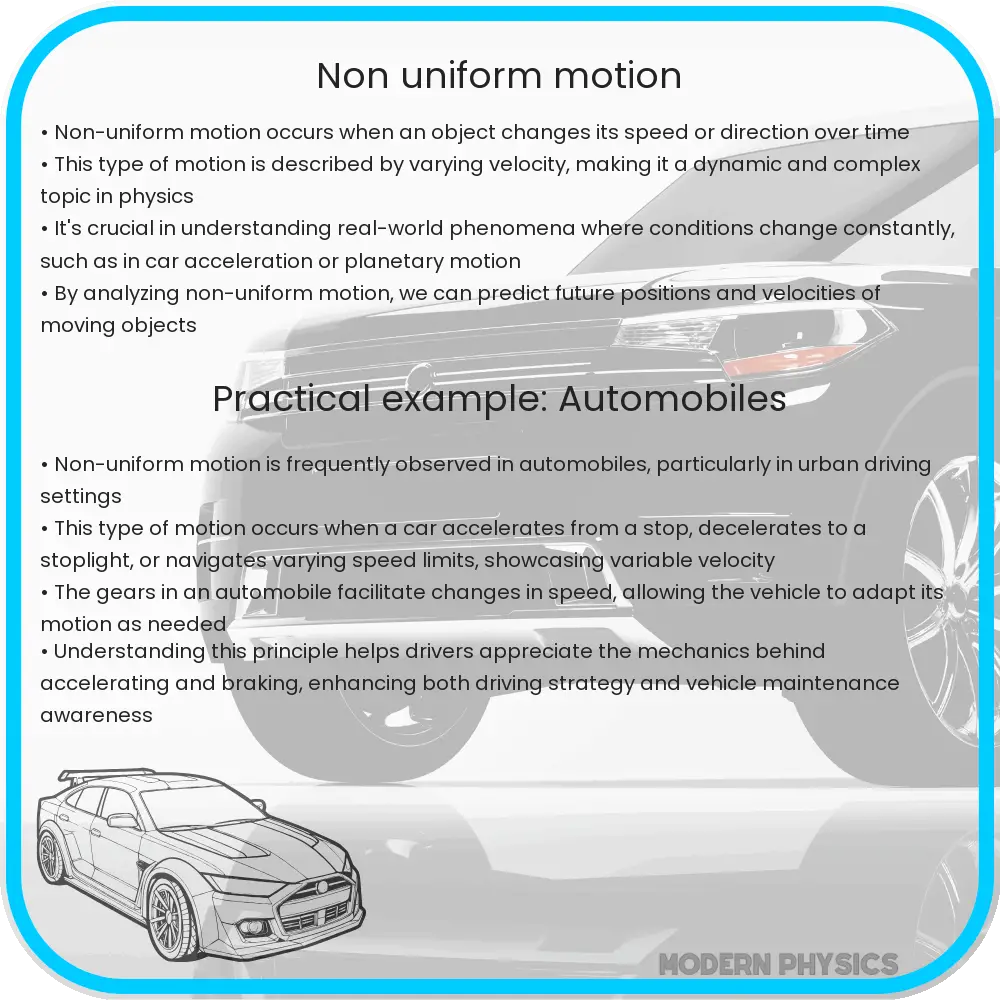Explore the dynamics of non-uniform motion in kinematics, from basic concepts to advanced applications in technology and science.

Understanding Non-Uniform Motion in Kinematics
Kinematics, a branch of mechanics, focuses on the motion of objects without considering the forces that cause this motion. A fundamental concept within kinematics is non-uniform motion, where an object’s velocity changes over time. This article delves into the insights, analysis, and patterns of non-uniform motion, offering a comprehensive understanding of its principles and applications.
Key Concepts in Non-Uniform Motion
Non-uniform motion can be categorized into two types: accelerated motion and decelerated motion. Accelerated motion refers to an increase in velocity, while decelerated motion signifies a decrease. The rate of velocity change is known as acceleration, which can be calculated using the formula:
\[ a = \frac{\Delta v}{\Delta t} \]
where \( a \) represents acceleration, \( \Delta v \) is the change in velocity, and \( \Delta t \) is the time interval.
Patterns of Non-Uniform Motion
Non-uniform motion is often represented graphically to illustrate the relationship between velocity, time, and acceleration. A velocity-time graph is a common tool used to analyze motion patterns. In these graphs:
- A straight line indicates uniform acceleration.
- A curved line suggests changing acceleration.
Analyzing Real-World Applications
Non-uniform motion is not just a theoretical concept but has practical applications in various fields, such as automotive engineering, aerospace, and sports science. For instance, understanding the acceleration patterns of a vehicle can lead to enhanced safety features and efficient fuel consumption.
In aerospace, non-uniform motion analysis is crucial for the design and trajectory planning of spacecraft. Similarly, in sports science, athletes’ performance can be optimized by studying their acceleration and deceleration patterns during different phases of movement.
Moreover, non-uniform motion plays a vital role in the development of technologies like autonomous vehicles and robotics, where understanding and predicting motion patterns are essential for safe and efficient operation.
Continued study and analysis of non-uniform motion not only deepen our understanding of physical principles but also drive innovation across various technological and scientific fields.
Advanced Techniques in Analyzing Non-Uniform Motion
To further understand non-uniform motion, advanced techniques like differential calculus are employed. Calculus allows for an in-depth analysis of motion, particularly in understanding how velocity changes at any given instant. The derivative of position with respect to time gives an object’s velocity, and the derivative of velocity provides acceleration. This mathematical approach is vital in fields where precision and instant analysis of motion are crucial, such as in robotics and high-speed trains.
Challenges and Future Directions
Despite its widespread application, analyzing non-uniform motion poses certain challenges. Accurately measuring and predicting motion in complex systems, like turbulent fluid flow or chaotic weather patterns, remains a significant hurdle. Future research in kinematics aims to refine models and simulations to better predict and control non-uniform motion in these complex systems.
Another burgeoning area is the integration of AI and machine learning in motion analysis. By harnessing vast amounts of data, these technologies promise to revolutionize how we understand and predict motion, leading to breakthroughs in various industries from autonomous vehicles to personalized medicine.
Conclusion
Non-uniform motion, a cornerstone concept in kinematics, provides critical insights into the movement patterns of objects. Its study encompasses basic principles like velocity and acceleration, and extends to advanced applications in numerous fields. Through graphical analysis, mathematical modeling, and the integration of new technologies like AI, the study of non-uniform motion continues to evolve, offering exciting possibilities for future innovations. Whether in engineering, science, or technology, understanding non-uniform motion is essential for progress and development in our increasingly dynamic world.
